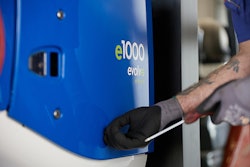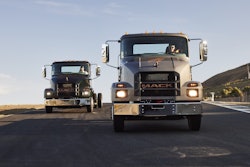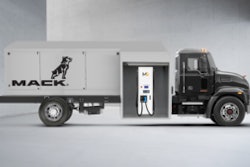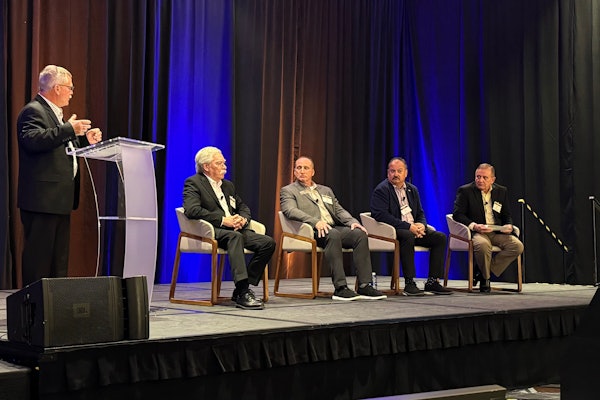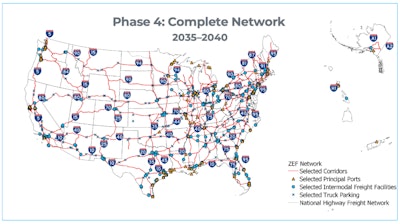
President Joe Biden's administration on Tuesday announced a new national strategy for zero-emissions freight trucks. It aims to help facilitate cooperation between federal agencies and the private sector to speed up alternative powertrain infrastructure across the country.
[SPECIAL REPORT: The transition to clean trucks is underway]
"For over a century, petroleum-fueled freight has transported vital food and resources to American families but at the same time, these vehicles have also contributed to lower public health, especially in densely populated communities," says U.S. Secretary of Energy Jennifer M. Granholm. "The Biden-Harris administration is addressing this issue head-on with innovative strategies to transform freight so it not only supports American families and businesses, but also protects the environment for future generations."
The Joint Office of Energy and Transportation and the U.S. Department of Energy say the National Zero-Emission Freight Corridor Strategy, developed in partnership with the Department of Transportation and the Environmental Protection Agency, will guide deployment of medium- and heavy-duty vehicle charging and hydrogen fueling infrastructure until 2040. It is, the administration says, designed amplify private sector progress with public investment, focus utility and energy planning, align industry activity and improve air quality in communities heavily impacted by diesel emissions.
The American Trucking Association — which recently held its Technology & Maintenance Council (TMC) Annual Meeting in New Orleans, where zero-emissions trucking and infrastructure was a hot topic — applauds the move.
"ATA is encouraged that the Biden administration has begun to recognize the unique challenges electrification poses to the commercial vehicle industry," says Jacqueline Gelb, ATA vice president of energy and environmental affairs. "Providing convenient and low-cost charging and hydrogen refueling infrastructure will be a key proof point for fleets to begin to adopt and operate zero-emission trucks."
Other industry groups are also on board with the federal government's plan.
"We are grateful that the Biden administration is recognizing the critical link between how freight moves today and the efficient build out of a nationwide network of charging stations for medium- and heavy-duty trucks," a statement from NATSO, representing truck stops and travel plazas, and SIGMA: America's leading fuel marketers says. "For this to work, it needs to impose minimal disruption on how businesses operate today."
The plan will roll out in four phases, the White House says. To help with the rollout, the Federal Highway Administration announced the designation of National EV Freight Corridors along the National Highway Freight Network and other critical roadways.
"Medium- and heavy-duty trucks in our current freight network contribute approximately 23% of greenhouse gas emissions in the U.S. transportation sector," says Shailen Bhatt, federal highway administrator. "These new designations and strategy will help to grow our national EV charging network, encourage clean commerce within the freight community, and support President Biden's goals of achieving net-zero emissions for the nation by 2050."
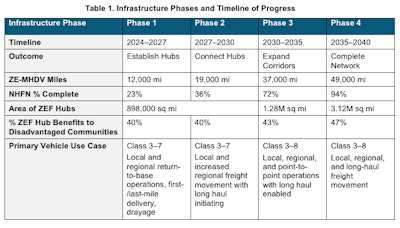 Source: National Zero-Emission Freight Corridor Strategy
Source: National Zero-Emission Freight Corridor Strategy
Phase one of the strategy establishes hubs in cities such as Chicago; St. Louis; Dallas; Houston; El Paso, Texas; Phoenix; Jacksonville, Fla.; Miami; Atlanta; Los Angeles; Seattle and more. It runs through 2027. The second phase, 2027-2030, will connect corridors around the country. This includes I-10, I-5, I-95, I-80 and more. Phase three expands the network from 2030-2035, covering much of the East Coast and expanding cross-country routes. Phase four, slated to be complete by 2024, criss-crosses the country both north-south and east-west and includes principal ports, truck parking and intermodal freight facilities.
The phased approach could make the strategy more executable and ease the way for zero-emissions infrastructure and trucking. Mike Roeth, executive director of the North American Council for Freight Efficiency, says we're in phase one now and, as far as the rest of the phases, he thinks the government did a good job.
"I think they got it right, as far as the future is going to go. It's not going to be easy," he says, but this is what we expect of government. "You look for them to help guide industry through transformations. It gives investors, regulators, the trucking industry and the utility industry a road map. It's a framework, a pathway. Maybe incentives and investment can follow."
[RELATED: NACFE gives updates on reports at TMC, including new one on SuperTruck]
Gelb says the roadmap will also help secure American manufacturing.
"Establishing guidelines and parameters for a national freight network will prioritize federal activities and investment to deliver the necessary supporting infrastructure to ensure our nation's supply chain can continue to deliver," ATA's Gelb says.
EV Realty develops, deploys and owns grid-ready EV charging hubs for commercial fleets. Patrick Sullivan, the company's CEO, says the strategy is a clear roadmap for states, utilities, fleets and other constituencies to move toward a zero-emissions future. Furthermore, he points out, the hub approach means cities most affected by commercial transportation emissions will see relief first.
"The National Zero-Emission Freight Corridor Strategy is thoughtful in its approach to sequence MHD ZEV charging infrastructure priorities with a near-term focus on hubs that align with local and regional, return-to-home-base trucks that will electrificy first," Sullivan says.
Nikola makes hydrogen-electric and battery-electric heavy-duty trucks. It's also working on solutions for hydrogen production and distribution — through it's Hyla brand — and electric charging solutions.
"Nikola appreciates the federal support and prioritization of hydrogen ZE-MHDV infrastructure to accelerate transportation decarbonization," says Alexia Bednarz, Nikola team lead for sustainability and government affairs.
Volvo made the commitment for all of it's global products to be fossil-fuel free by 2040.
"We see this as a real positive step in the effort to accelerate charging infrastructure for medium- and heavy-duty vehicles," says Dawn Fenton, vice president of government relations and public affairs at Volvo Group North America. She says the federal strategy is in line with that plan.
[RELATED: Volvo completes acquisition of Proterra battery company]
"We are very committed to this goal," she says. And, for that reason, Volvo, Daimler and Navistar launched Powering America's Commercial Transportation (PACT) earlier this year. "We, as the industry, see this as a major concern. We want to do everything we can to accelerate the availability of charging infrastructure."
Navistar joined the other OEMs' accolades.
"The path to a zero emissions future requires a strategic focus on the deployment of reliable charging infrastructure to support the zero emissions trucks that will travel on heavily used freight corridors," says Kevin Maggay, senior public policy manager for Navistar. "Navistar commends the work of the Joint Office of Energy and Transportation as they come together to develop an interagency strategy to build reliable and affordable charging infrastructure for zero emissions trucks."
Daimler Truck North America, naturally, also agrees with the feds' road map.
"We appreciate the work of the Joint Office of Energy and Transportation to propose a comprehensive and actionable strategy that recognizes both the necessary lead time as well as the importance of providing a cohesive infrastructure network for commercial transportation," says John O'Leary, CEO and president of DTNA. "To achieve the shared ambition to decarbonize the industry by 2040, establishing the electric charging and hydrogen refueling stations required by zero-emissions trucks has to begin now."
